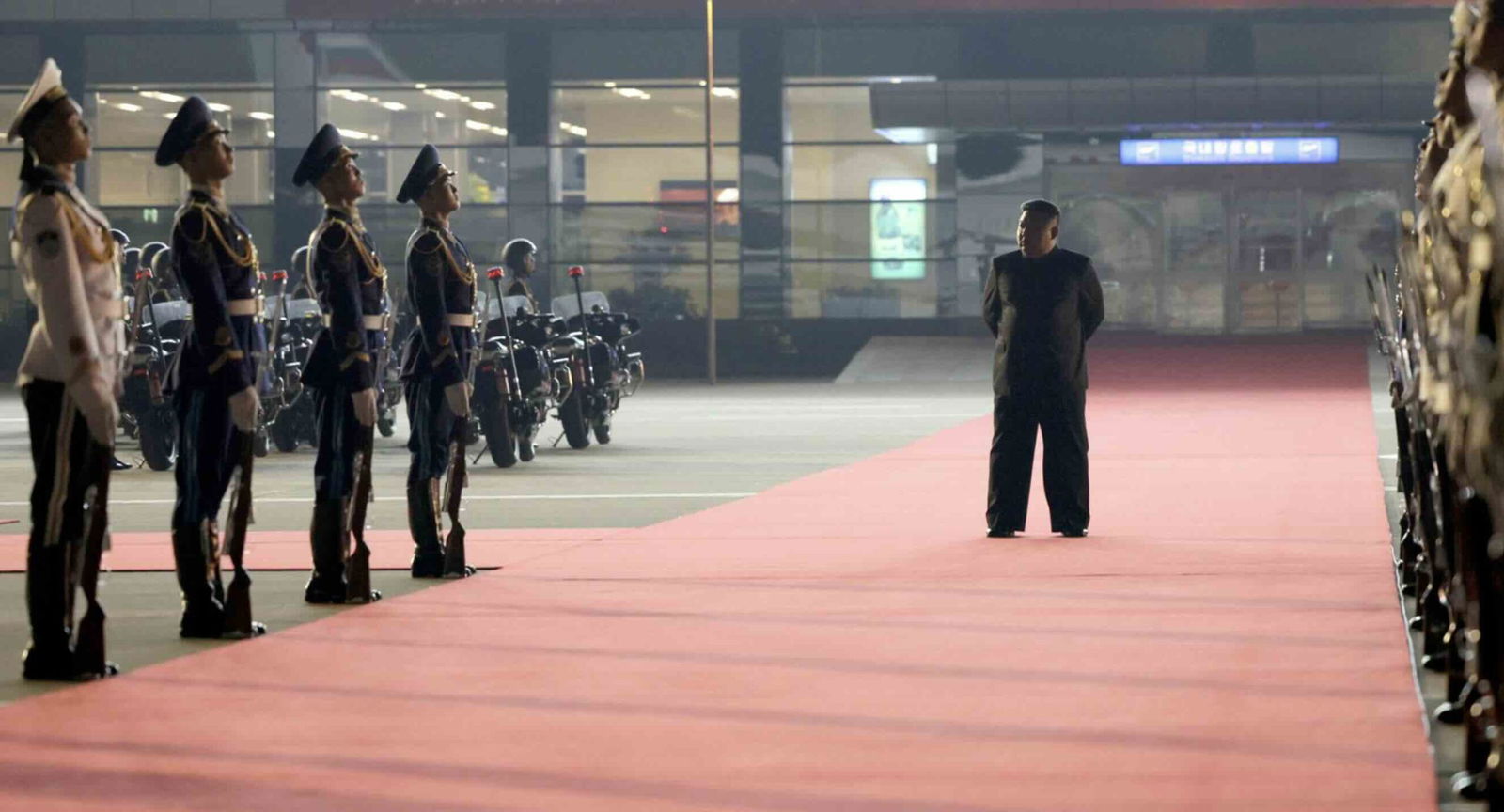

Welcome to this Halloween edition of The Intelligence Brief… on Thursday, it was learned that North Korea had launched a new intercontinental ballistic missile (ICBM) that showcases the country’s move toward use of powerful new projectile technologies. In our analysis, we’ll be exploring 1) what we know about the country’s latest missile test, 2) the projectile’s high-altitude operation, 3) what the launch conveys about the country’s concerning aspirations, and 4) what the technical aspects of the missile launched on Thursday reveals about the country’s military objectives.
Quote of the Week
“The United States condemns these actions and calls on the DPRK to refrain from further unlawful and destabilizing acts.”
– U.S. Indo-Pacific Command statement
Latest News: In recent news from The Debrief, researchers have traced the source of mysterious ultrahigh-energy gamma rays to a surprising location, and archaeologists have revealed more than 6,500 previously hidden ancient Mayan sites. Meanwhile, readers of The Debrief are curious about the status of the Pentagon’s most talked about secretive hypersonic aircraft… could it soon take flight? You’ll find links to all our recent stories at the end of this week’s newsletter.
Podcasts: In podcasts this week, on the latest installment of The Debrief Weekly Report, Kenna and Stephanie discuss the secret powers mice may have and other scientific mysteries. Also, in a Halloween installment of The Micah Hanks Program, I explore terrors associated with time, which include strange paradoxes, time travel, and other cosmic enigmas. You can find all our past episodes on The Debrief’s Podcasts Page.
Video News: On the latest episode of Rebelliously Curious, Chrissy Newton is joined by Daniel Otis, a Canadian journalist who discusses his recent investigations into the shoot-down of an unidentified object in Canadian airspace last February. Be sure to check out other great content from The Debrief on our official YouTube Channel.
With that all behind us, it’s time we shift our focus over to the concerning “October surprise” U.S. officials learned of this morning, following the latest concerning missile launch by one of its adversary nations in the Pacific.
North Korea Launches an ICMB
On Thursday, frightening news arrived just in time for Halloween as it was announced that North Korea had launched a new advanced intercontinental ballistic missile (ICBM), in a test that precedes the looming U.S. election by just days.
Launched at 7:10 a.m. local time, the missile reportedly reached its peak altitude while passing over the Sea of Japan before descending west of Okushiri Island.
The test further escalates mounting tensions between North Korea and the United States, along with its allies in the Pacific, and is believed to have achieved the longest flight time presently known involving a missile launched by the nation.
A High-Altitude Test
The missile test was announced by Japan’s defense ministry, and notably also represents what is believed to be North Korea’s highest-altitude test involving such a weapon, having reached an unprecedented 4,350 miles.
Outpacing previous missiles in range and altitude by a significant margin, the recent test even surpassed the observed capabilities of the Hwasong-18, a solid-fuel missile North Korea tested less than a year ago.
It is believed the missile’s high-altitude operation may have been employed as a strategy to help reduce the international repercussions of long-distance operations, which would have had more significant territorial impact. Such practices are in keeping with past strategies North Korea has employed during similar tests.
Thursday’s test advances the country’s objectives of having an ICBM capable of reaching the United States, potentially armed with a nuclear payload. The timing of the launch, carried out in advance of a contentious American election, also appears to be partially in response to the deepening collaboration between Japan, South Korea, and the United States.
North Korea’s Dangerous Aspirations
North Korean leader Kim Jong Un, who was on-site for Thursday’s launch, has sharply condemned the U.S.’s strategic partnerships with other Pacific nations, and justified Thursday’s launch as a response to ongoing military exercises its enemies have carried out nearby.
The U.S. and other nations have expressed similar unrest over Pyongyang’s military cooperation with Moscow. Recently, North Korea deployed thousands of troops to Russia, where some are believed to have participated in the country’s ongoing war against Ukraine.


On Wednesday, U.S. Secretary of Defense Lloyd Austin, joined during a media appearance by Republic of Korea Minister of National Defense Kim Yong Hyun, said the U.S. is “closely tracking the unprecedented level of direct military cooperation between Russia and the [Democratic People’s Republic of Korea].”
“The evidence now suggests that North Korea has sent around 10,000 soldiers to train in eastern Russia,” Austin said yesterday, “and some of these DPRK troops have already moved closer to Ukraine.”
Following Thursday’s missile test, Japan’s Chief Cabinet Secretary Yoshimasa Hayashi and South Korea’s President Yoon Suk Yeol condemned the launch, saying such actions significantly raise security concerns for the region.
Technology in Transition
A significant factor involving Thursday’s test involves the technical capabilities exhibited during the missile test, which showcase Pyongyang’s transition toward using solid-fuel technologies.
Whereas liquid-fueled systems require on-site preparation that impose significant limitations on their use and curb the speed of their deployment, solid-fuel ICBMs are capable of much faster launch times, which also makes them less easily detected early on.
The tactical advantages afforded by solid-fuel missiles—namely increased launch speed—play a significant role in the changing approaches North Korea is taking to its military operations. Despite the fact that U.S. officials expected such a test, Pyongyang’s lack of regard for international sanctions and U.N. Security Council resolutions, which currently prohibit such ballistic missile activities, showcase a rising concern amid mounting international pressure.


On Thursday afternoon, a statement issued by the U.S. Department of State characterized the launch as a “flagrant violation of multiple UN Security Council resolutions.”
“We strongly urge the DPRK to immediately cease its series of provocative and destabilizing actions,” the statement read, “that threaten peace and security on the Korean Peninsula and beyond.”
Here are the top stories we’re covering right now…
That concludes this week’s installment of The Intelligence Brief. You can read past editions of our newsletter at our website, or if you found this installment online, don’t forget to subscribe and get future email editions from us here. Also, if you have a tip or other information you’d like to send along directly to me, you can email me at micah [@] thedebrief [dot] org, or Tweet at me @MicahHanks.


Here are the top stories we’re covering right now…
- Black Holes and Dark Energy May be Connected, as Potential Link Emerges Between Two Cosmic Mysteries
New research proposes a profound connection between two of the universe’s greatest mysteries: black holes and dark energy.
- Scientists Have Discovered a New Way to Create Superheavy Elements
Researchers at Lawrence Berkeley National Laboratory say they have discovered a new way to create superheavy elements.
- Astronomers Tracking Ultrahigh-Energy Gamma Rays Reveal the Origins of a Violent Galactic Mystery
An international team of researchers has traced the source of mysterious ultrahigh-energy gamma rays to the heart of the Milky Way.
- Lidar Imagery Reveals More Than 6,500 Unexplored Ancient Mayan Settlements, Including Pyramids
Lidar scanning technology has revealed over 6,500 ancient Mayan settlements, including pyramids hidden by dense jungle forests.
- Debunking Myths: Autism Doesn’t Increase or Protect Against Conspiracy Beliefs, New Research Shows
New research finds that people with autism are no more susceptible to conspiracy beliefs than the general public.
- Scientists Invent Ultrathin Film that Protects Electronics by Absorbing Electromagnetic Radiation
Materials scientists have invented a composite material that protects electronics by absorbing over 99% of electromagnetic radiation waves.
- Mysterious Objects Detected by Astronomers Could Point to ‘Complex Structure’ at the Edge of Our Solar System
Astronomers say they have discovered mysterious objects in a region beyond the known Kuiper Belt, which could point to a complex structure at the fringes of our Solar System.
- Ancient Remains of a Previously Unknown “Swamp Dweller” Have Been Discovered in Colorado
Paleontologists have discovered a previously unrecognized hairy “swamp dweller” in Colorado that thrived during the dinosaur era.
- Could Alien Life Thrive Without a Home Planet? Study Suggests Self-Sustaining Habitats May Be Possible Beyond Earth
Researchers suggest that self-sustaining habitats could allow alien life to survive and thrive in space without the need for a home planet.
- Suicide Risk Is Highest on This Day of the Week, New 50-Year Survey Reveals
A survey of five decades of data found that the risk of suicide increased on one particular day of thew week and one day of the year.
- AI’s Puzzle-Solving Limitations: Vision-Language Models Struggle with Human-Like Pattern Recognition
A new study shows that even today’s most advanced AI vision-language models can’t compare with human comprehension capabilities.
- National UFO Historical Records Center Opens New Facility, Showcasing Largest UFO Archive in North America
America’s most extensive collection of original historical documents related to UFOs has just found a new home.
- “The Wormhole Dilemma: Could Advanced Civilizations Use Time Travel to Rewrite History?
Harvard astronomer Avi Loeb looks at whether wormhole technologies could allow time travel, and if so, what the implications might be for history.
- Genome Breakthrough Brings Scientists One Step Closer to Reviving Extinct Thylacine
Scientists are one step closer to reviving the thylacine, thanks to key advances that include a recent genome breakthrough.
- An Ancient Norse Saga Could Hold the Key to Identifying the “Well-Man”
New research offers clues to the identity of the “Well-man,” an enigmatic set of human remains that are described in an ancient Norse saga.
- New “Death Clock” AI Longevity App Claims It Can Predict When You’ll Die
A new AI longevity app called Death Clock says it can predict when you’ll die. Here’s how it can also potentially help people live longer.
- Scientists Are Trying to Figure Out How to Kill the ‘Tree of Heaven’
Virginia Tech scientists are developing a fungus that can use the movements of the invasive spotted lanternfly to kill the Tree of Life.
- This Drug-Free Patch is Using Electricity to Combat Bacterial Infections
Researchers have developed a skin patch that uses imperceptible electric currents to stop bacterial infections.
- U.S. Space Force Tracking Debris After “Anomaly” Leads to Unexplained Satellite Loss
This week, we examine what U.S. Space Force officials and others have said about a Boeing-built satellite that recently exploded due to an “anomaly.”
- UFOs and Counterintelligence: Fake UAP Programs?
This week, we look at statements by U.S. officials involving fake UFO programs, forged documents, and deceptive counterintelligence measures.
- Do Jedi Mice Carry Very Tiny Lightsabers? This week on The Debrief Weekly Report…
On this week’s episode, Kenna and Stephanie ask whether mice are actually Jedi in disguise, and explore the Red Planet’s icy mysteries.
- Department of Energy Scientists Capture Imagery of Perplexing Object That Evades Easy Description
Scientists with the U.S. Department of Energy say an object once predicted only in theory has now been captured in 3D X-ray images.
- MIT and Cal Tech Physicists Spot Something They’ve Never Seen Before: A ‘Black Hole Triple’
Physicists from MIT and Cal Tech say they have discovered evidence of a black hole triple, something they have never seen before.
- Researchers Say They Are Close to Successfully Crafting Synthetic Lifeforms
Dutch researchers say they are now attempting to build synthetic life forms from the ground up, and potentially more efficient than nature.
- Why Are These Ancient Black Holes More Massive Than Astronomers Expected?
Harvard astronomer Avi Loeb explores the question of why some early black holes are overly-massive, defying astronomer’s expectations.
- Mysterious Features on Barren Planets and Asteroids Offer Clues to What Lies Beneath Their Surfaces
Mysterious features on the surfaces of planets and asteroids are helping researchers understand what might lie beneath their surfaces.
- Storytelling for Justice: Director X and Scientists Explore Cinema’s Power in Justice Reform
Recent research explores how popular cinema can serve as a catalyst for positive change in justice reform.
